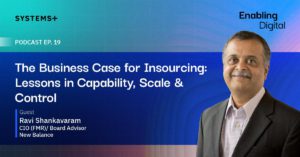Virtual Captives are gaining momentum in the IT outsourcing space. They soon will be making deeper inroads in the BPM space in the coming times. We take a closer look at virtual captives and all its aspects in our new blog.
To thrive in a highly competitive and fast-paced business environment, flexibility and efficiency are always vital to an organization’s success. And to achieve these, companies turn to setup captive units in an offshore location—a talent pool and an extra pair of hands. Creating remote captives not only guarantees lower labor costs, but even more so, a supportive business environment where companies can enjoy local tax incentives and harness a highly educated workforce.
Here’s what Sapan Choksi, CEO at Systems Plus has to say about the various outsourcing approaches and how the outsourcing and offshoring world has evolved over the years.
“When one thinks and talks about outsourcing, typically they think there are only three models. The onsite approach, the nearshore approach and the offshore approach. And they all come with their own sets of pros and cons. But fundamentally, from the onsite perspective, it’s typically the most expensive but does provide the most control. It’s also considered to be the most productive approach. Now there’s a nearshore approach, which is cheaper than onsite. Time Zone differences are managed well in this approach. However, it does not afford the client the necessary transparency and control because you don’t know what is necessarily happening behind the scenes. And finally, there is the offshore approach which is usually the cheapest. But it certainly offers the least transparency and control. The key issue here is that people tend to overlook what outsourcing is fundamentally all about. Outsourcing is all about people; great talent will equal great value. So, making outsourcing work better and costs less is the key to success.
Then of course the nearshore options, which are typically in the same time zone, Mexico, Belize, Caribbean’s sometimes Canada, depending on the service, and again, works great for support because of time zone alignment, but a skill set is limited for short. And then we have Eastern Europe, it has been coming up a lot lately. Some great skills out there, but language is a fundamental challenge. And it’s not as economical as some of the other options which are based out of Asia and Asian options are typically China. Unfortunately, language is a huge risk there and more than that, the IP risk, even though it’s cheaper, people are still worried and for all the right reasons that whether my IP is safe or not. And then finally, there is India, but within India itself, there are actually two models. It’s the legacy offshore, and, great skills do exist there.
And, of course, the language is not a problem, but transparency does or can become an issue. And, of course, the turnover is another problem that our clients do talk to us about. But to sort of overcome a lot of those problems. There’s another model which is the India GIC model, which, is a global in-house center, which gives the best cost structure and full control with the best technical skills. So, these are the kind of choices that people have been seeing and how the outsourcing and offshoring world has evolved to.”
A managed GIC sometimes referred to as the managed captive model is a proven framework for plugging these gaps and creating more value for your enterprise. It gives you all the strategic benefits of a Global In-House center, while mitigating your legal risks, protecting your IP risks and solving your day to day management issues. Plus, access to a quality talent pool means that your managed GIC can serve as the R&D and Innovation Hub for your enterprise and contribute positively to your bottom-line.
Today, the technology landscape has changed dramatically, with the advent of Cloud, PaaS, Automation tools, DevOps practices etc. Tools and platforms to support such practices have made it easier for teams to work together and reduce time-to-market. Agile has now given way to distributed scaled Agile. Jeff Bezos famously said: “In today’s era of volatility, there is no other way but to re-invent. The only sustainable advantage you can have over others is agility, that’s it. Because nothing else is sustainable, everything else you create, somebody else will replicate.”
As companies begin operating in the next normal and as GICs seamlessly integrate with the extended global enterprise, there’s a strong case for reimagining the traditional value proposition.
Virtual Captive as an offering is undoubtedly poised to gain popularity and momentum in the coming times due to the sheer value and advantages it promises to offer. Virtual Captives will be mainly of great utility to clients who intend to gain back control and ownership of already matured and transformed processes that have remained with a Managed Services provider for long. Virtual Captive has already gained traction in the IT outsourcing space and will undoubtedly be making deeper inroads in the BPM space in the coming times.
The benefits of the MGIC platform are many – Not only is it a fully transparent model with complete control, but it’s also EBITDA accretive. Additionally, the MGIC platform gives you access to high-quality tech talent with deep domain expertise in emerging areas like AI, data science, and cloud. To discover it for yourself, reach out to us for a free consultation along with a free price comparison matrix tailor-made to your skill needs.






